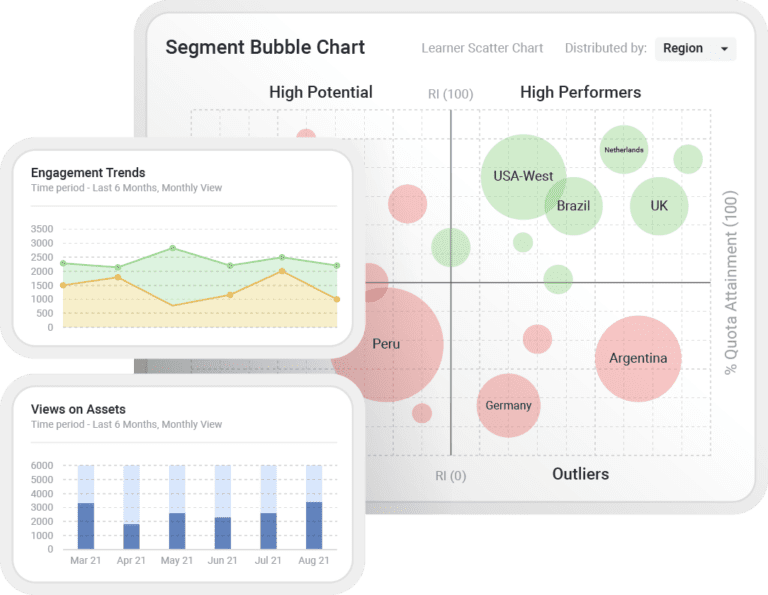Customers are the lifeblood of any organization. Without customers, you won’t make any money or be in business for long.
Modern B2B customers have high expectations. Businesses must prioritize meeting these expectations across the customer lifecycle.
Establishing a solid customer enablement strategy is key to ensuring that your customers are happy and that they’ll stay long-term.
But what is customer enablement? You’ve come to the right place if you ask yourself that question.
In this post, we’ll answer all of your burning questions about customer enablement, including:
- What is it?
- What are the top benefits?
- What’s the difference between customer enablement and sales enablement?
- What does a customer enablement manager do?
What is customer enablement, and why is it important?
In B2B, the word “enablement” comes up a lot. You’re at least somewhat familiar with concepts like sales enablement, revenue enablement, marketing enablement, and others.
But what about customer enablement?
B2B buyers expect a lot from B2B businesses. If you deliver outstanding experiences before purchase, a prospect is more likely to convert. If you continue to provide the right tools and experiences post-sale, your customer retention rate will grow.
It’s key to making that second part possible.
Also known as client enablement, it’s a business practice focused on improving customer experiences. It’s focused on improving customer experiences and ensuring each customer has the tools and resources they need to get the most from your product or service.
Why does customer enablement matter?
Customers’ satisfaction increases when they have what they need to succeed with your product. Happy, satisfied customers are more likely to stick around long-term – and refer your business to others in their network. As a result, your revenue will grow.
What are some customer enablement examples?
These initiatives can take a number of different forms. Initiatives vary based on factors including:
- Your goals
- Your customers’ needs
- Your budget
For example, an organization’s customer enablement strategy may be to provide new customers with a named customer success manager (CSM). A large enterprise customer may even have a dedicated CSM. The CSM will schedule recurring calls with the customer to get them up to speed with the platform, answer their questions, and provide ongoing support and information to ensure they get the most from their investment.
Customer education is another example. For example, a B2B SaaS company may create a customer webinar series that shares best practices for using the SaaS solution. Some organizations even offer formal training courses, and customers can receive certifications for completion and mastery.
Customer feedback is another common component of a customer enablement program. Asking for feedback is the only way to know whether your products and experiences are meeting a customer’s expectations. If there are problem areas, you can work to improve – and increase the customer’s satisfaction and likelihood of retention. Customers may also share feedback that can help inform future product developments and enhancements.
What are the benefits of customer enablement?
When it’s done well, customer enablement can deliver some big benefits. Let’s look at some of the top benefits.
Better customer experiences
Modern B2B buyers have high expectations for great experiences. Furthermore, experiences have a large (and growing) impact on customer conversion and retention.
According to Salesforce, eight in 10 customers say a company’s experience is just as important as its products or services.
B2B companies must prioritize consistently delivering experiences that meet (or even exceed) customers’ expectations. Improving customers’ experiences is a key goal of any strategy or initiative.
Increased retention
Acquiring new customers is important. But it’s equally important to retain the customers you have. After all, acquiring a new customer is significantly more expensive than retaining an existing customer.
Successful initiatives boost customer satisfaction. Happy, satisfied customers are more likely to renew.
can lead to a
Even a small increase in retention can positively impact revenue. Research tells us that even a 5% increase in retention can increase revenue up to 95%.
Upsell and cross-sell opportunities
When customers are satisfied with their experiences, they’re more open to hearing about additional product offerings. So, by prioritizing customer enablement, you can increase upsells and cross-sales.
More referrals
Successful initiatives boost customer satisfaction. Satisfied customers are more likely to refer your product or service to others. In fact, 85% of business buyers have recommended a company to others based on service.
Research tells us referrals convert 30% better than leads generated elsewhere. Plus, they have a 16% higher lifetime value.
Actionable insights for improvement
Customer feedback is an important part of any program. Asking for feedback is an important way to show your customer that you truly listen and value their input.
The feedback you receive provides insight into what a customer is happy about and where there are opportunities for improvement. Then, you can step in when necessary to help improve the customer’s experience. This will increase their satisfaction and decrease their likelihood of canceling.
It’s also important to look for themes in customers’ feedback. These themes can shed light on opportunities to enhance existing products or services or even develop new ones.
Customer enablement vs sales enablement: What’s the difference?
They are certainly related. But they aren’t the same thing.
Sales enablement aims to ensure sales reps have the training, tools, content, and information needed to engage prospects and close deals. Enablement professionals leverage sales enablement analytics software to understand how their initiatives are (or aren’t) impacting sales performance.

On the other hand, customer success enablement is focused on improving customer experiences and ensuring each customer has everything they need to be successful with your product or service.
They are both key ingredients to customer satisfaction. Sales enablement ensures prospects have great experiences during the sales cycle. Customer enablement ensures they have great experiences after they’ve signed on the dotted line.
Customer enablement vs. sales enablement: What’s the difference?
| Customer enablement | Sales enablement | |
|---|---|---|
| Goal | Improve customer experiences to increase customer retention | Ensure sales reps have the tools, training, and information they need to be effective and efficient in their roles. |
| Audience | Existing customers | Go-to-market teams (sale reps, AEs, BDRs, customer success, etc.) |
| Stage of customer lifecycle | Post-sale | Pre-sale |
| Examples of KPIs | Customer satisfaction, retention, referrals, and lifetime value | New rep ramp time, quota attainment, sales cycle length, average deal size |
| Examples of initiatives | Named customer success team, webinars, training, best practices guides | Sales onboarding, ongoing training, role-plays and other practice opportunities, sales coaching |
| Primary responsible party | Customer enablement manager/customer enablement team | Sales enablement manager/sales enablement team |
| Other key teams | Sales, Marketing, Customer Success, and Product | Sales, Marketing, Sales Ops, and Customer Success |
Roles and responsibilities of a customer enablement manager
It isn’t the responsibility of a single person. Instead, it’s a team effort.
The team must collaborate closely with other key functions, including (but not limited to) sales, marketing, implementation, and customer success. The manager leads the charge.
The responsibilities of a manager vary from organization to organization. However, their responsibilities often include:
- Collaborating with key teams – including sales, marketing, and customer success – on an ongoing basis
- Creating strategies that increase product adoption and boost customers’ success
- Developing training, which may include a mix of formats like webinars, recorded videos, and written materials
- Leveraging tools to create and implement initiatives and measure their impact
- Analyzing usage data to understand how customers are currently using the product and where there may be underutilized features and functionality
- Developing relationships with customers and soliciting feedback that will help inform future programs and initiatives
- Making continuous optimizations to the strategy and program based on data and feedback
- Leading a team
How customer enablement managers measure success
Clearly, customer enablement managers have a lot of responsibilities. How do they measure success?
It varies from organization to organization. However, some metrics teams must track include:
- Adoption of training and other programs
- Customer satisfaction
- Net Promoter Score (NPS)
- Customer retention rates
- Lifetime value
- Referrals
Boost loyalty and retention with customer enablement
Today’s B2B buyers have high expectations. Businesses must make it a priority to deliver outstanding experiences across the entire customer lifecycle.
Sales enablement ensures sales reps have the training, tools, and information they need to engage buyers before purchasing. However, customer enablement is key to ensuring your customers have outstanding experiences after they’ve signed on the dotted line.
Customer enablement ensures customers have the right tools, information, and support to get the most value from your solutions. It sets your customers up for success, which increases satisfaction. These happy, satisfied customers are more likely to be long-term customers and spread the word about your solutions to others.
Customer Enablement with Mindtickle
Ensure your customer-facing teams are well-equipped with the knowledge and skills needed to engage and support customers effectively.
Request a Demo


 By Helen Waite
By Helen Waite

 By Rahul Mathew
By Rahul Mathew